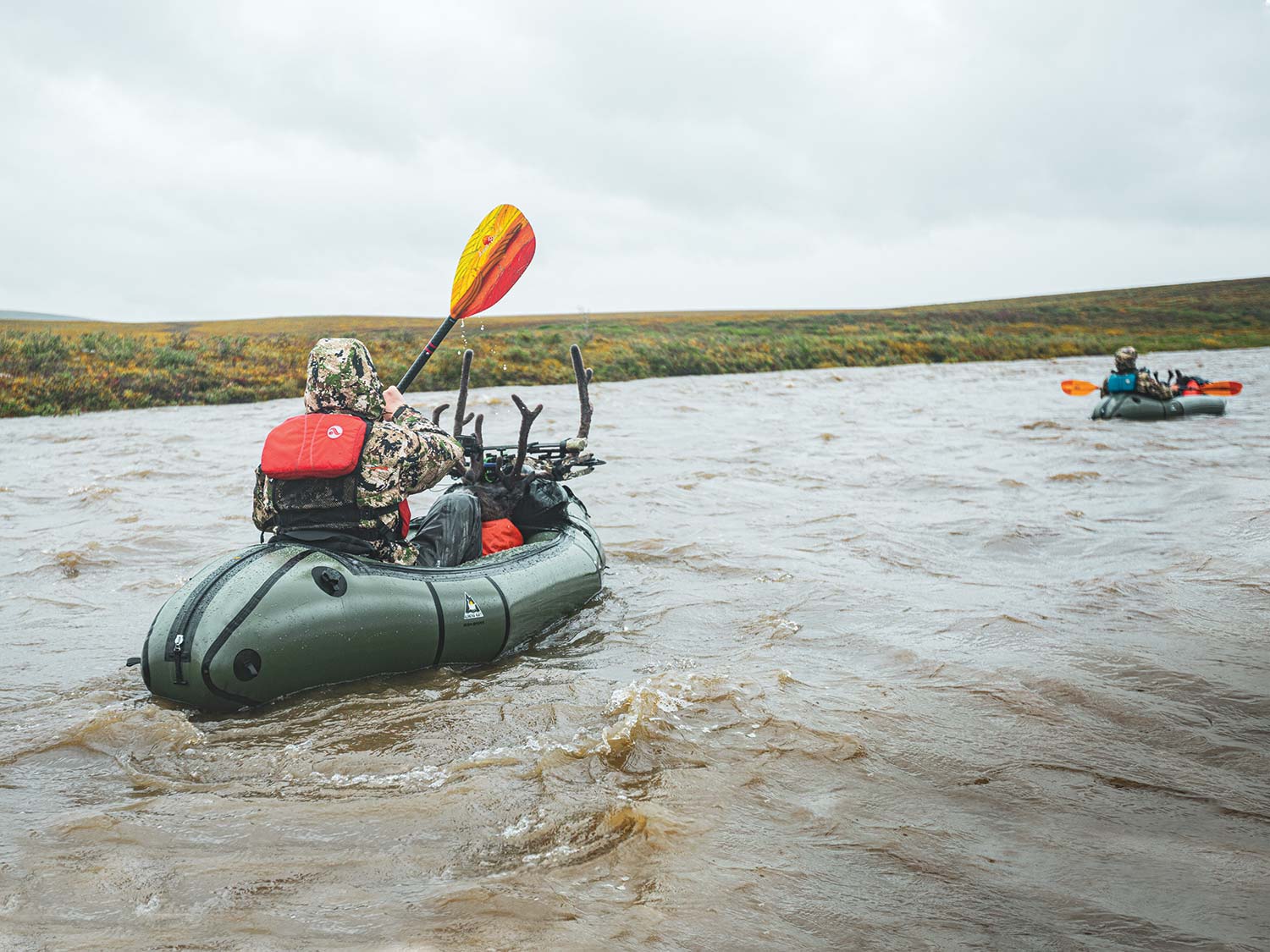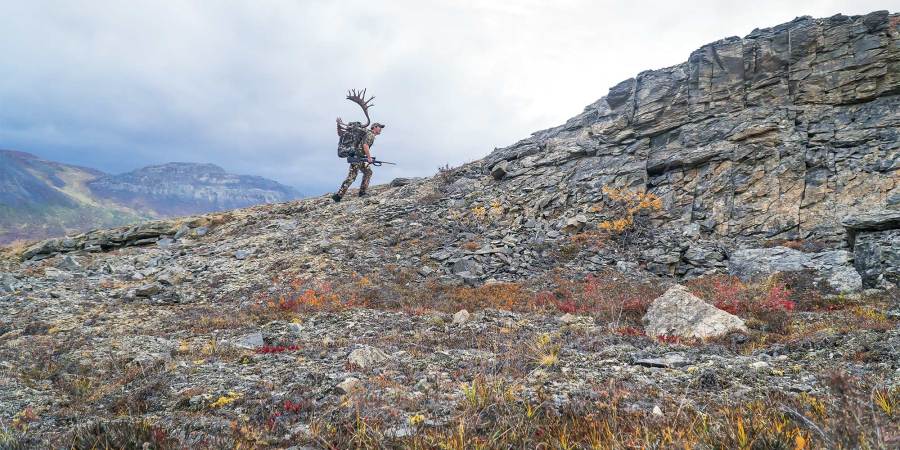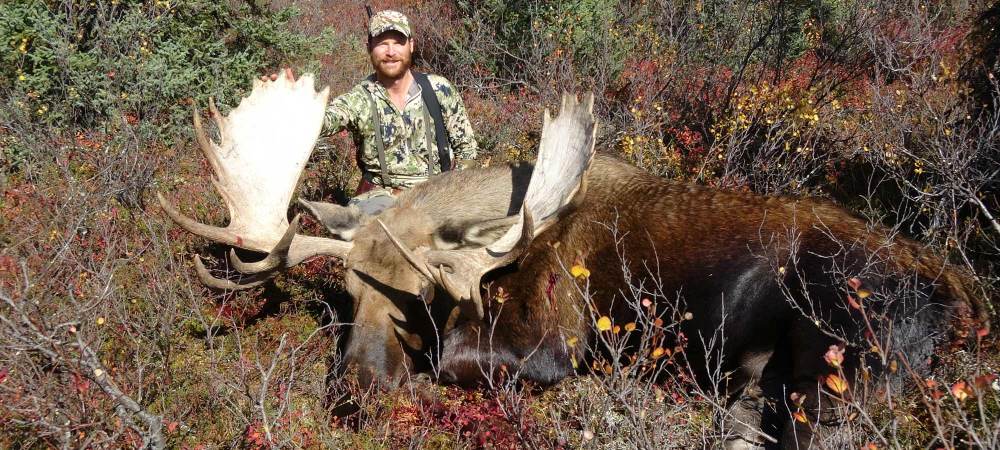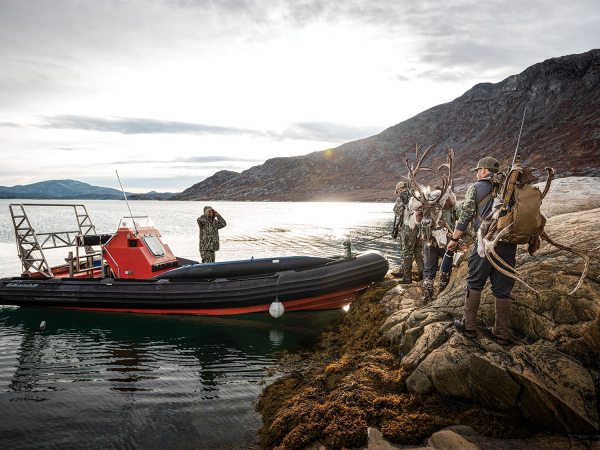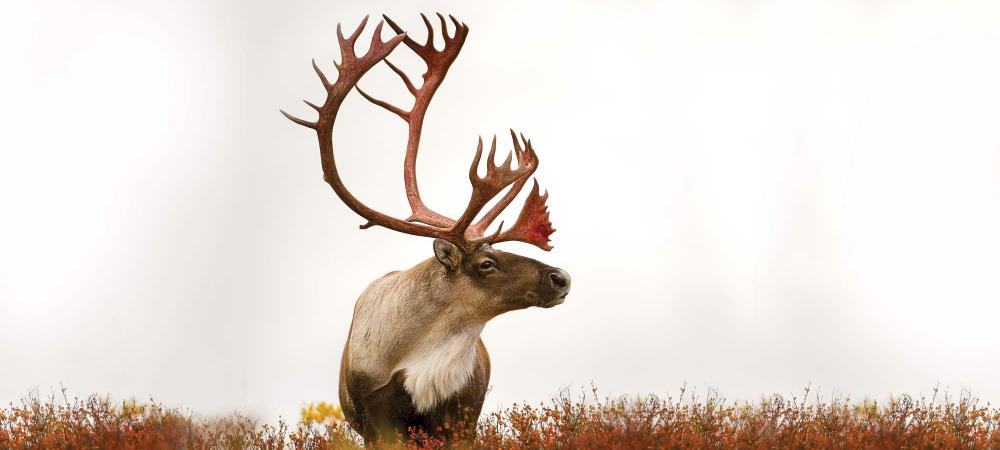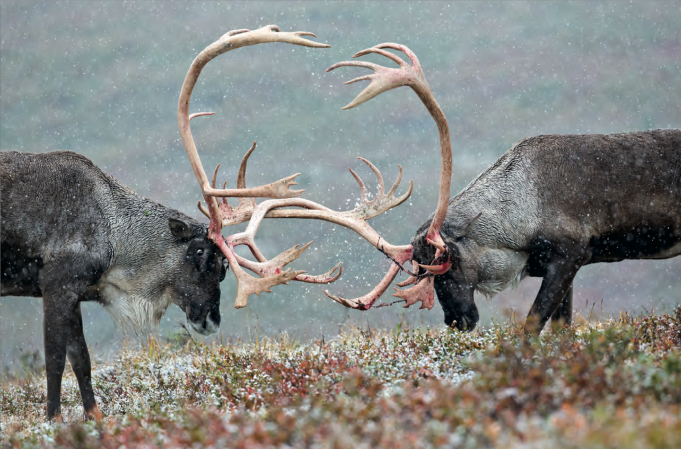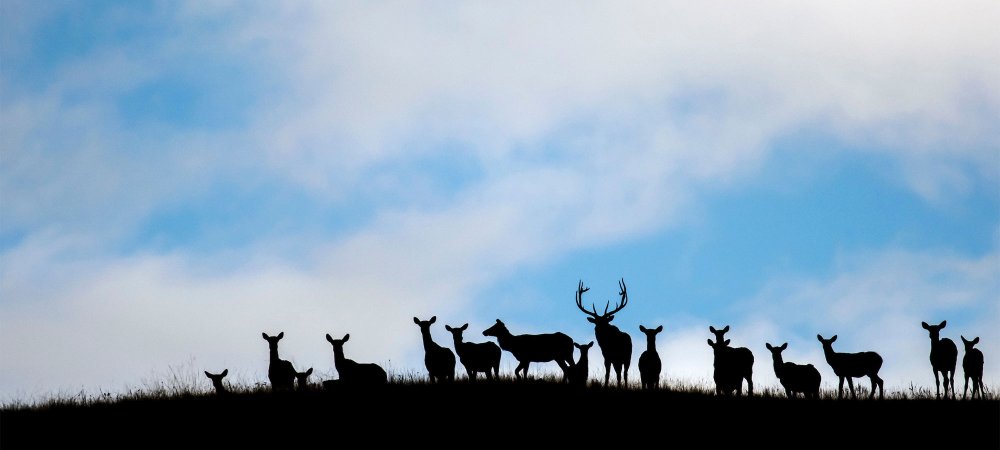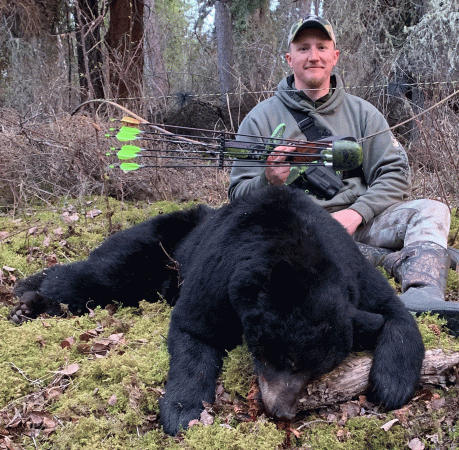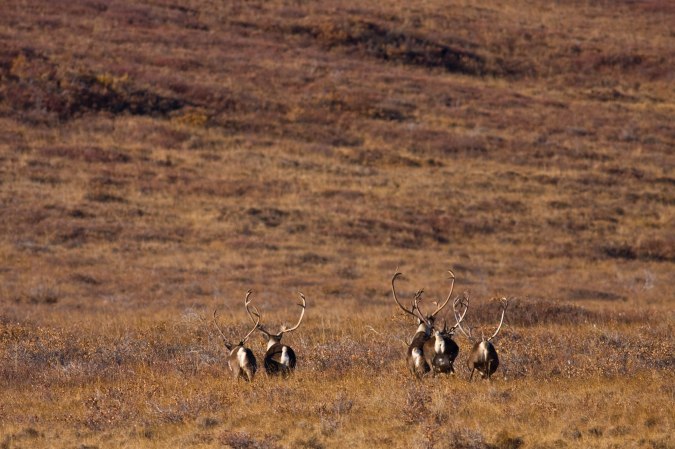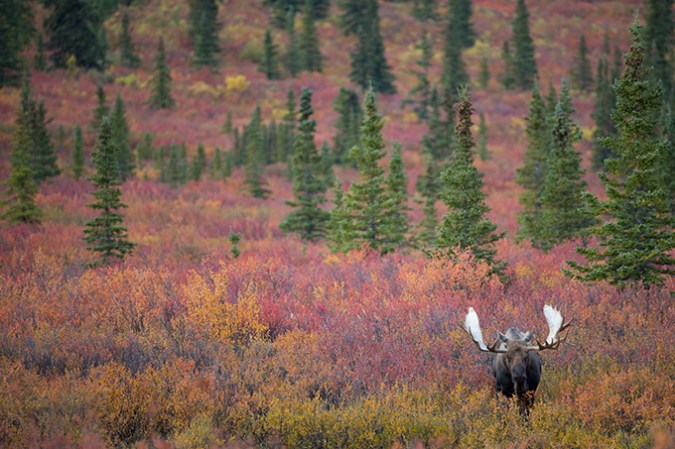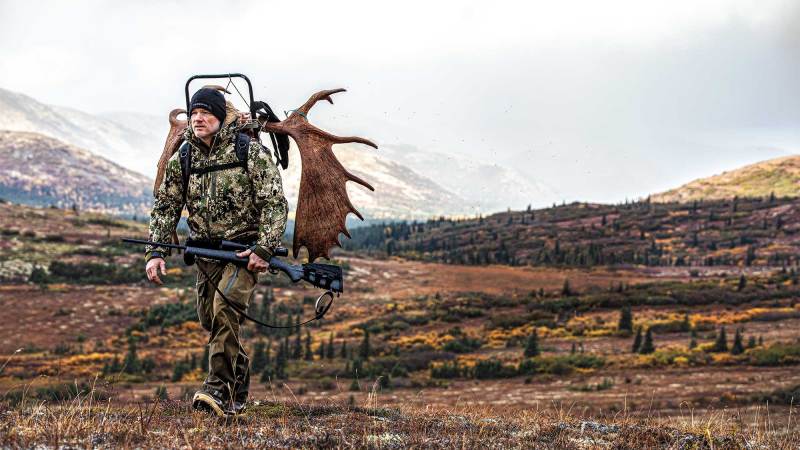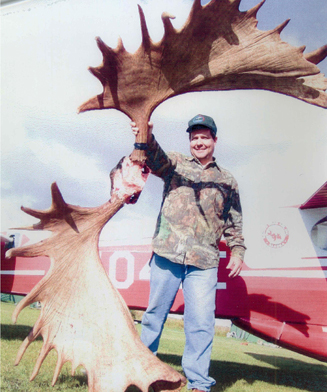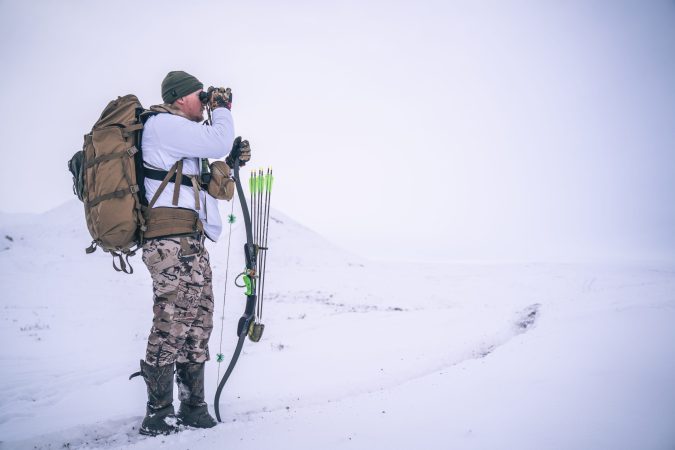The fact that I was even on this trip at all was pure luck. I stumbled into the invite—a float-hunt for caribou through a remote corner of Alaska’s Brooks Range—because another hunter had dropped out. Hard hiking, rafting down fast-flowing rivers, and enduring cold, wet weather would all be part of the deal. I felt like I had been preparing for this trip my entire life.
I was born in Broad Ripple, Indiana, a neighborhood in northern Indianapolis that sits on the banks of the White River. I was drawn to the water as a kid. My dad would ferry us out into the river in our rowboat, and we’d fish and explore the ever-changing sand islands of our backyard. Even then, I understood the river could deliver adventure, and that its power demanded respect. When I was older, I found myself dialing in my kayak roll and calling out commands from the back of a raft as a whitewater guide. Leading expeditions through slot canyons built the character needed to withstand any plunge into a cold-water pool. Floating the waterways of the Southwest, I marveled over historical petroglyphs that depicted rivers as lifelines, giving water to plants and animals, and helping humans travel and connect with each other.
Hunting for me came later. I had settled in Colorado, where my brother slowly brought me into the fold. I had spent most of my adult life working as an adventure educator, but hunting was a fresh, visceral way to interact with nature. My first hunt was life-changing: My brother conjured up a bull elk from the timber, and I made a clean shot. Years later, I’m still chasing that feeling.
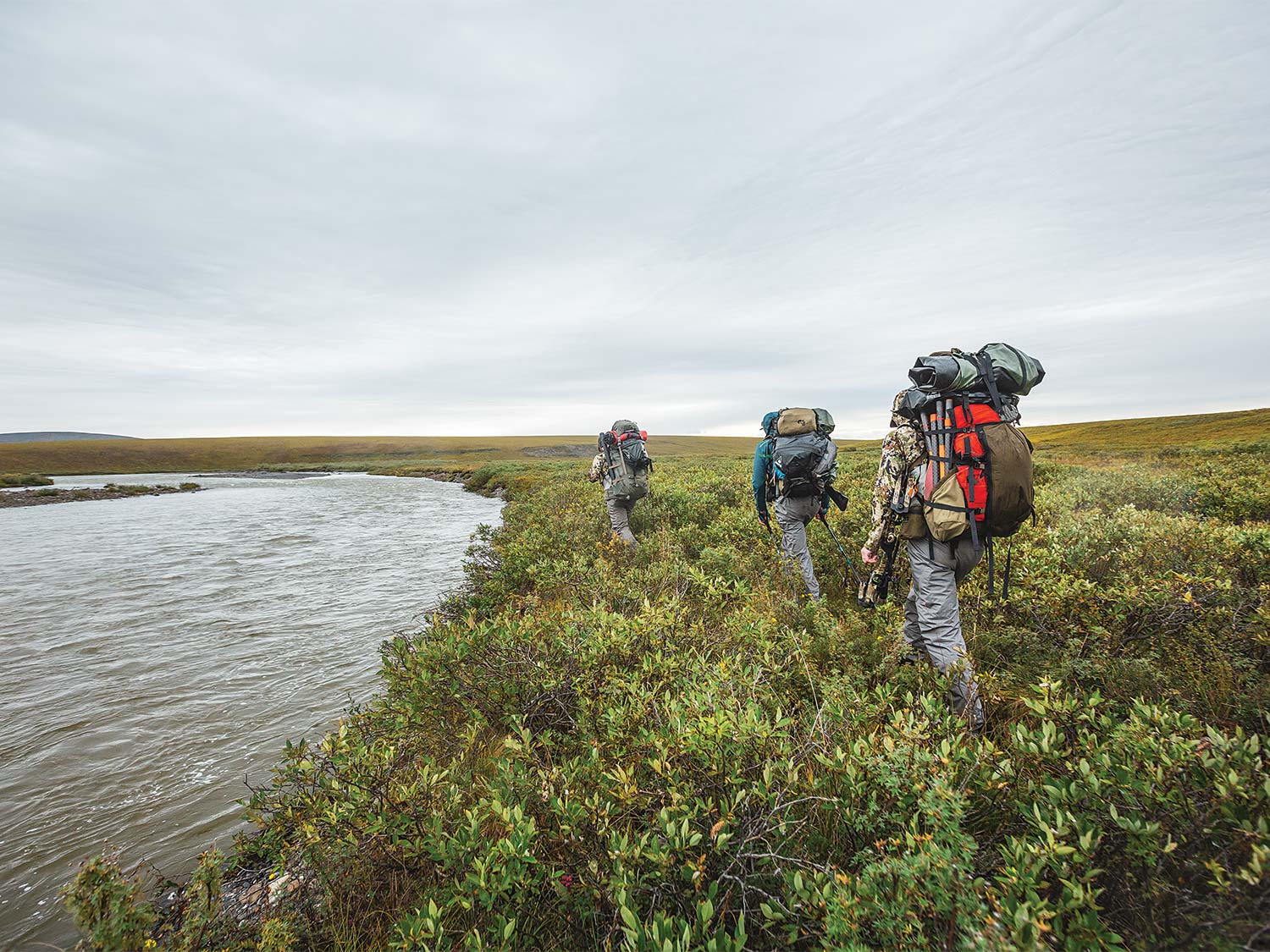
The River Road
The highway leading to our caribou hunt is paved with oil. My hunting partners—Joe Risi, a rep for Backbone Media; Thor Tingey, CEO of Alpacka Raft; and Craig Okraska of Maven optics—and I made a 10-hour drive north from Fairbanks on the Dalton Highway, which was built to access the oil fields of Prudhoe Bay and support the pipeline that brings a flow of oil south.
I chew on the idea of wanting to protect a place while also relying on its resources. More than anything, I look forward to trading the road and the van for the river and a raft. We’ll be floating through the unforgiving terrain inhabited by the Porcupine caribou herd. These animals face a harsh environment and natural predators, but also the threats of climate change, mining, and pressures from native and non-resident hunters. Despite all that, the caribou here are prospering. While the overall abundance of caribou worldwide is declining, the Porcupine herd has experienced a steady increase in population, from approximately 123,000 animals in 2007 to about 200,000 in 2017.
We arrive at the put-in a little late, but the Alaskan twilight lingers as we prepare our equipment; the sun won’t set until after 10 p.m. In the morning, we drink strong coffee and look over the magnificent Sagavanirktok River and the mountains from which the mighty river starts its journey. Below the snowy peaks are countless tributaries, each one pumping more cubic feet of meltwater into the Sag than the last. The plan is to hike as far as we can up one of the tributaries, and then float back down in rafts heavy with caribou meat.
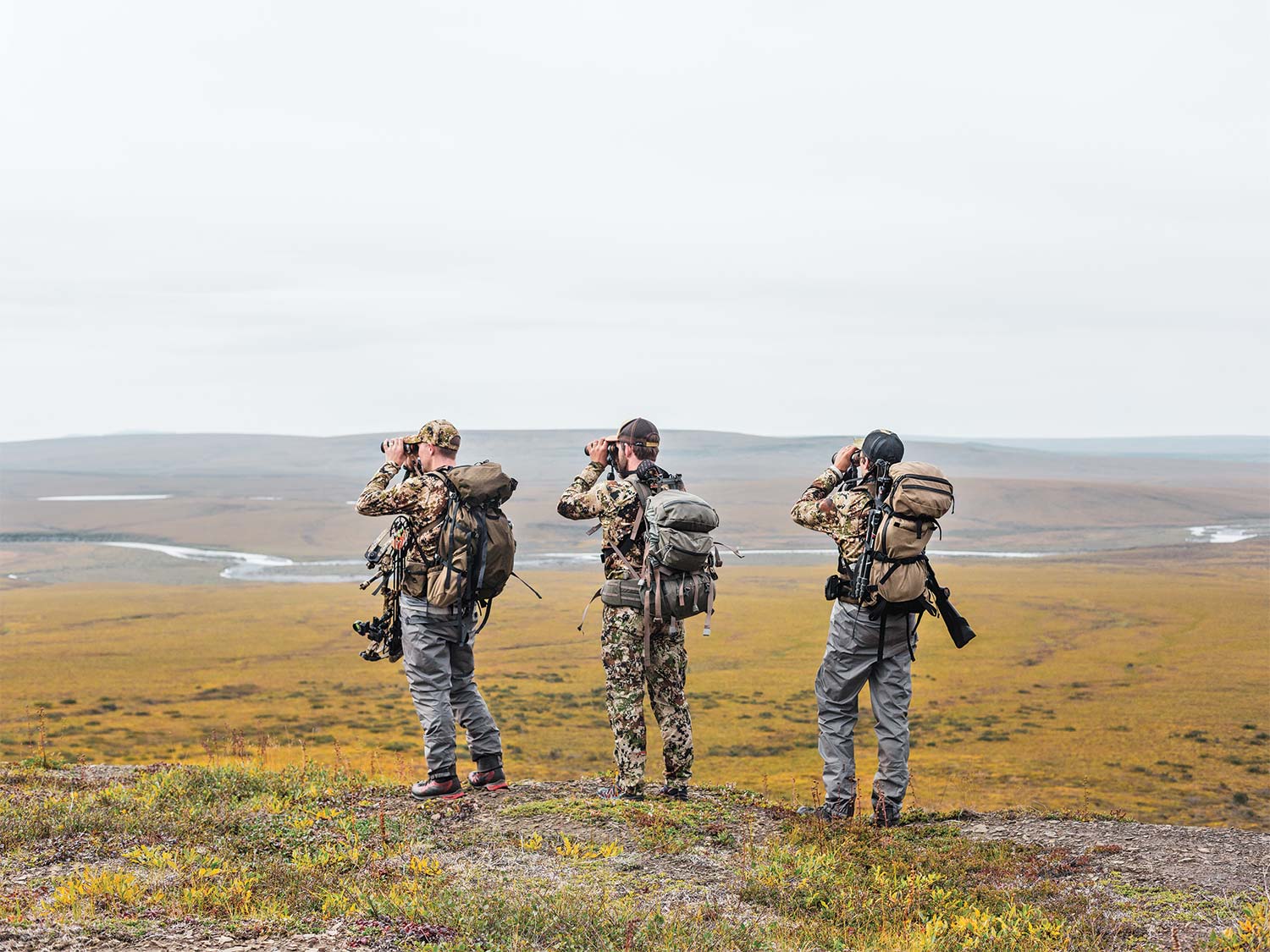
I learn to inflate my Mule packraft with a lightweight sil-nylon bag in three minutes, tops. We float 5 miles to a small tributary, then pull up on a gravel bar to deflate our rafts and lash them to our packs—on top of my 40-pound pack, my rafting gear weighs only an additional 12 pounds. Before we’ve gone too far, though, I hear yelling.
“Bear, bear!”
I spot a huge mane on top of what I expect to be a grizzly bear’s hump swaying through the willows on the far side of the river. I pull up my binocular only to see the flattened face of a massive musk ox. He catches our wind and slowly ambles out of sight. Now this is Alaska.
We are a few hours into the hike when we stop to check our maps. There’s a 5-mile archery-only buffer on each side of the Dalton Highway, which prevents rifle hunters from taking pot shots at animals they spot from the road, and we have just crossed that boundary. If our group sees a caribou from here on up the river, it’s fair game for both me and Risi.
After trekking 10 miles upriver, we find a flat patch of lichen from which we can glass all evening. I look out across the tundra and spot tufts of white bobbing our way. “Caribou!” I whisper-yell.
The small herd is only about a mile away across the river, but it’s already been a long day. Instead of going after them, we decide to set up camp for the night and hope to locate them again in the morning.
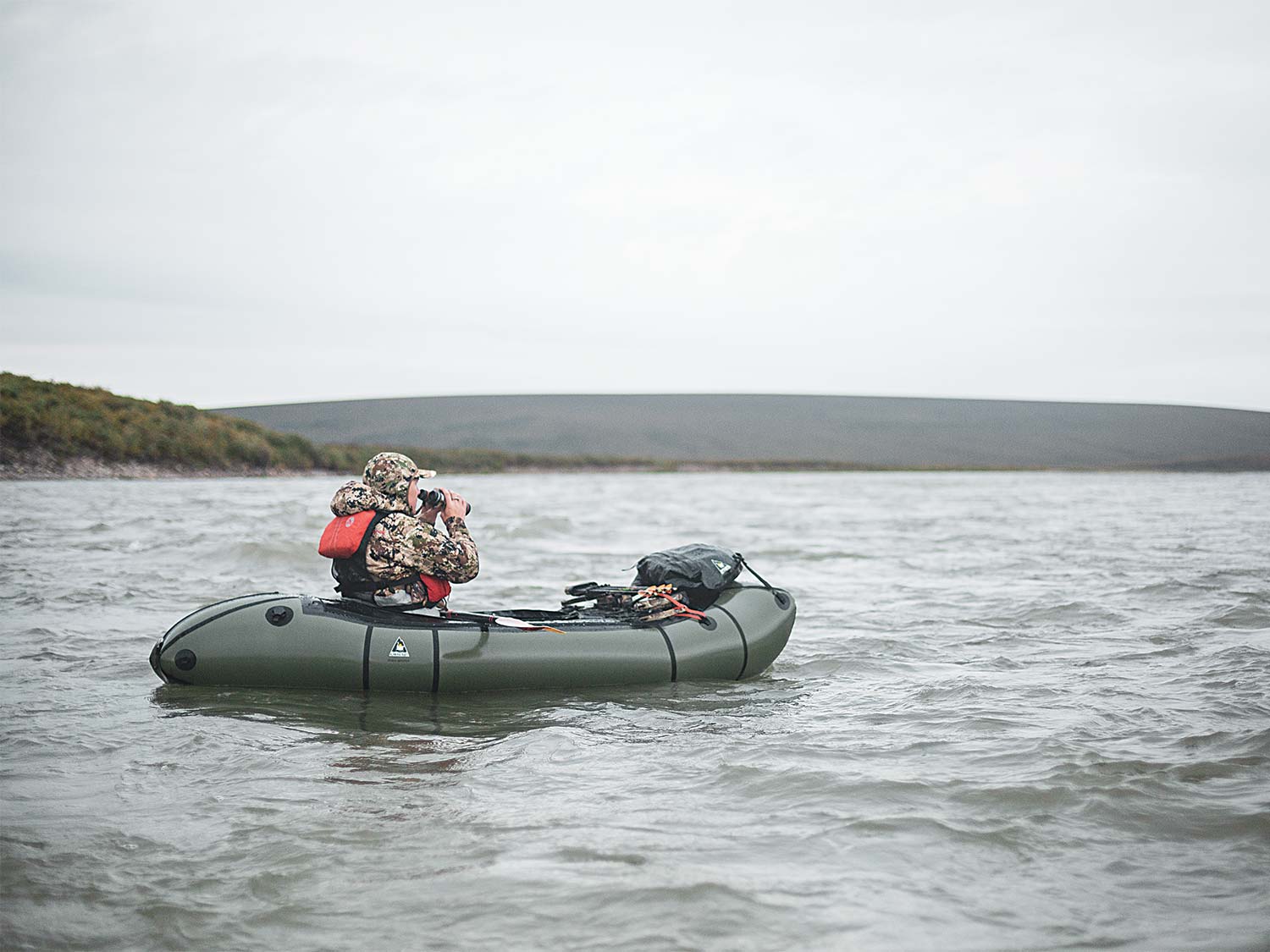
Double Bulls
The long hike and the quiet flow of the river pull me into a deep slumber. We sleep for a full 10 hours, and by the time we break out our glass in the morning, the caribou have moved off.
We decide to head in their general direction, working toward a high point 2 miles away to glass new country. The main channel of our river is only 30 feet wide, but it’s deep and fast enough that wading is not an option. We quickly inflate one boat, and Tingey ferries each of us across the river.
Read Next: A Caribou Hunting Adventure in Alaska, No Guides Required
An hour later, after a slow walk across tundra littered with caribou sheds, we stand atop a craggy outcrop. We strip off our water-logged boots and packable waders. We never see the sun, which stays mostly hidden behind low, gray clouds, but a few rays peek through the gloom and make the day feel less damp.
In the distance, I glass a lone bull running like he’s being chased by a predator—but there are no wolves in sight. The caribou is just trotting up and down a small river, frolicking. He seems to cover a few miles in as many minutes. It’s astounding to watch him. I relax just long enough to eat a snack, but when I pick up my binocular again, incredibly, I see a bull running full-gas right toward us. Startled, I drop everything and start muttering, “Move, move. He’s coming!” My buddies think I’m kidding—until they see the bull for themselves.
The caribou stops in a depression in the terrain, just out of sight, probably half a mile away. We huddle up to devise a plan. Okraska and Tingey will stay back and relay hand signals as Risi and I try to flank the bull from opposite sides. Whoever gets into better position will take the shot (but only when we can see our hunting partner is clear). Risi is a ski racer, and he closes the gap to the caribou much faster than I can. From a distance, I see the caribou catch Risi’s wind, and then do the opposite of what I expect: He actually moves closer to inspect the danger. A fatal mistake. I watch Risi make the shot, then hear the crack of the rifle an instant later.
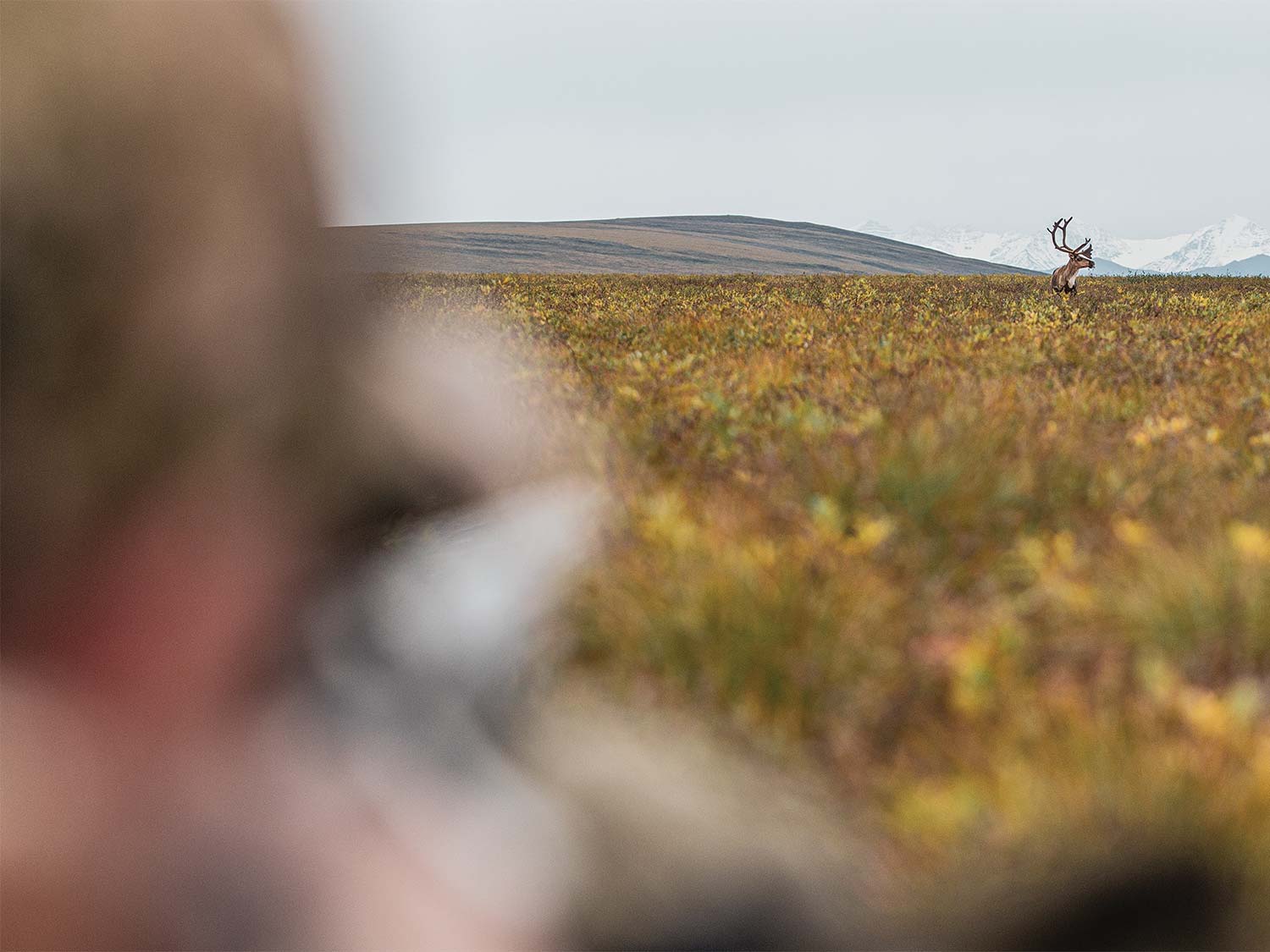
While Risi retells the story of his stalk, I pull up my bino to glass in the direction his caribou came from and notice there’s a bull still standing there, grazing on lichen. Apparently, Risi’s caribou was an interloper in our scene, and the original bull I spotted had actually stayed in the same spot the whole time.
I do some quick calculations. We have one animal down, and we can’t hike any farther upriver with all this meat. So, my hunt needs to happen either here or somewhere downriver. My objective for this trip is to soak up the adventure, but also to take home some caribou meat. It’s an easy call. Okraska and I decide to sneak off after the second bull while Risi and Tingey butcher the meat and pack it back to camp.
A mile and a half of hellish tussocks separate us from the grazing bull, but we have a slight hill and creek bed to hide our approach. We slow our pace when Okraska spots the antlers of the feeding caribou on the horizon. Judging distance is tricky in this landscape, and 10 minutes later, we are crab-walking the final few yards. We inch to within 210 yards before I pull off my pack and settle behind my rifle. The motion catches the bull’s attention, and he walks tentatively in our direction, nose out, trying to catch our wind. At 150 yards, he finally turns broadside, and I squeeze the trigger.
I present the downed bull with his last meal by placing a bit of lichen in his mouth, and send him off with a prayer. Venison diplomacy—sharing wild game as a way to introduce nonhunters to hunting and conservation—will be this bull’s legacy. Okraska and I spend the next few hours quartering the bull and packing meat into game bags. It’s going to be a slow, heavy trip back to the river, hiking over tussocks toward a never-ending skyline. Three miles and many hours later, we stash the meat near the river and finish the final 3-mile walk to camp in the rain. By the time we get there, we’re soaked to the bone. It looks like we fell in the river.
I slowly come to life the next morning, feeling every inch of my body protest. Each muscle is firing in the most peculiar places. My eyes open, and I remember yesterday’s hunt; my blood-stained hands still smell of caribou. A soft rain is falling again. We take the boats upriver to retrieve my bull and collect driftwood. If we are going to stand around in the rain, it will be next to a warm fire.
Floating 125 pounds of meat down 3 miles of river couldn’t be more fun. The cold rain stings my hands, but the effort of pulling the paddle through swift water is as delicious as cutting a perfectly rare steak with a sharp knife.
At every deep bend in the river, we pull over to collect more wood, filling Risi’s boat until it looks like there’s a giant bird’s nest in the bow. We spend the rest of the day testing the strength of our campfire cooking skills, devouring a variety of cuts and a whole caribou heart, which somehow seems even bigger than an elk’s.
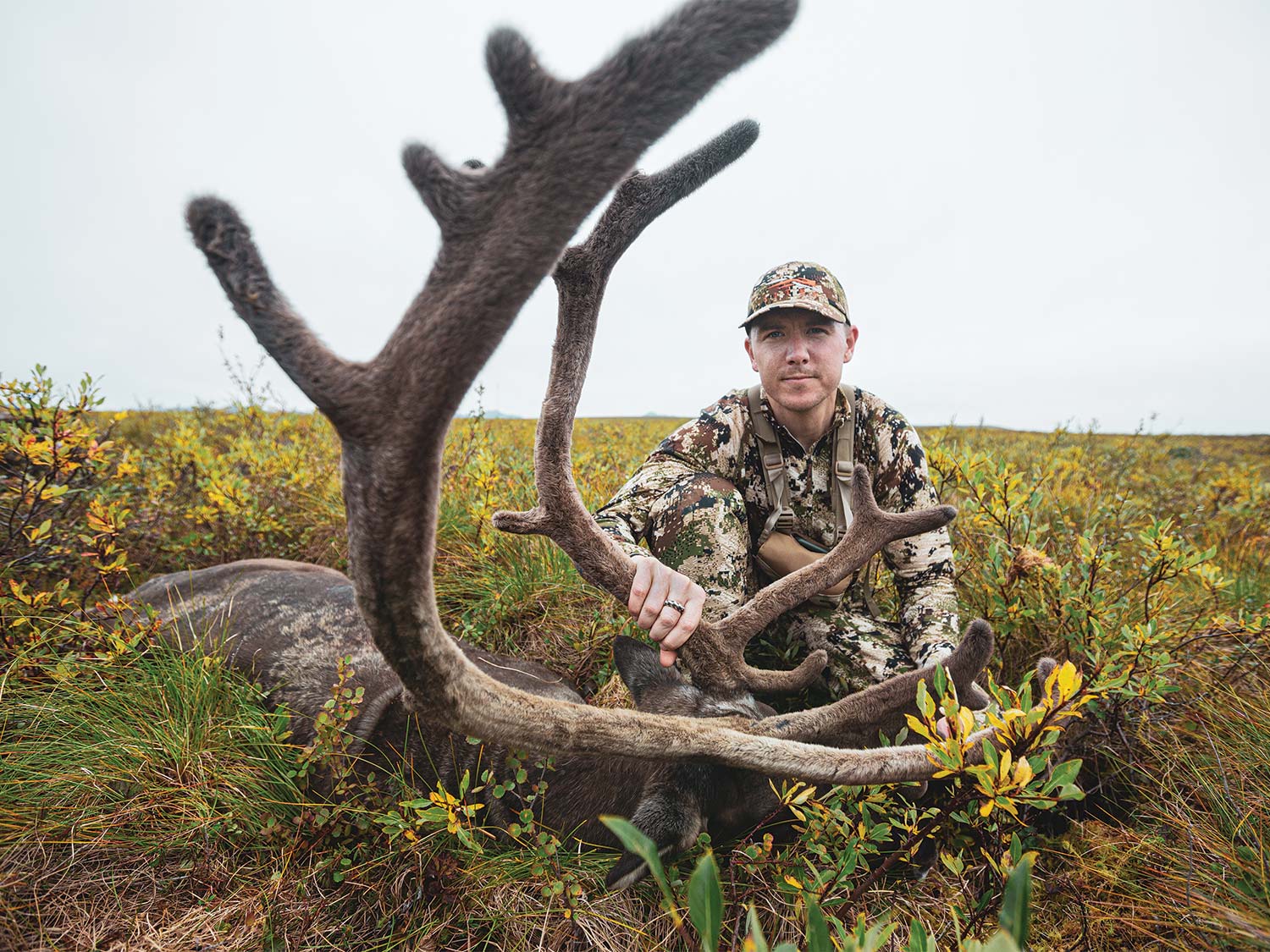
We supplement the backstraps with coconut oil and the berries that are scattered everywhere on this landscape. You just have to get down on your knees and start exploring to find blueberries, salmonberries, soapberries, crowberries, and bear berries. Red hues color this landscape like a Monet painting; the lines are striking from afar, but the closer you look, the more details you find.
We’ve burned through our piles of wood, and it’s time for another round of deep sleep, but I have a nagging thought as we stand on the braided riverbed. It’s been raining all day, and the river is rising ever so slightly.
Tributaries of the Sag are pushing huge amounts of water into the main channel. With wet meat and even more rain in the forecast, we decide to break camp early and float out first thing the next morning. The swift current bounces us down the river. Later, we would find out the Sag had risen from 6,000 cfs at the start of our trip to a surging 30,000 cfs by the time we were ready to pack out.
But as with most aspects of this hunt, luck is on our side. Even with our rafts loaded with meat, we coast down the tributary and cross the mighty Sag without trouble. There were so many variables in this trip—so many little things that needed to go right, and so many more that could have gone wrong. The low roar of the Sag reminds me of our good fortune as we load the van and point it south back toward Fairbanks.
But the river is all behind us now, and it’s time to dry out.
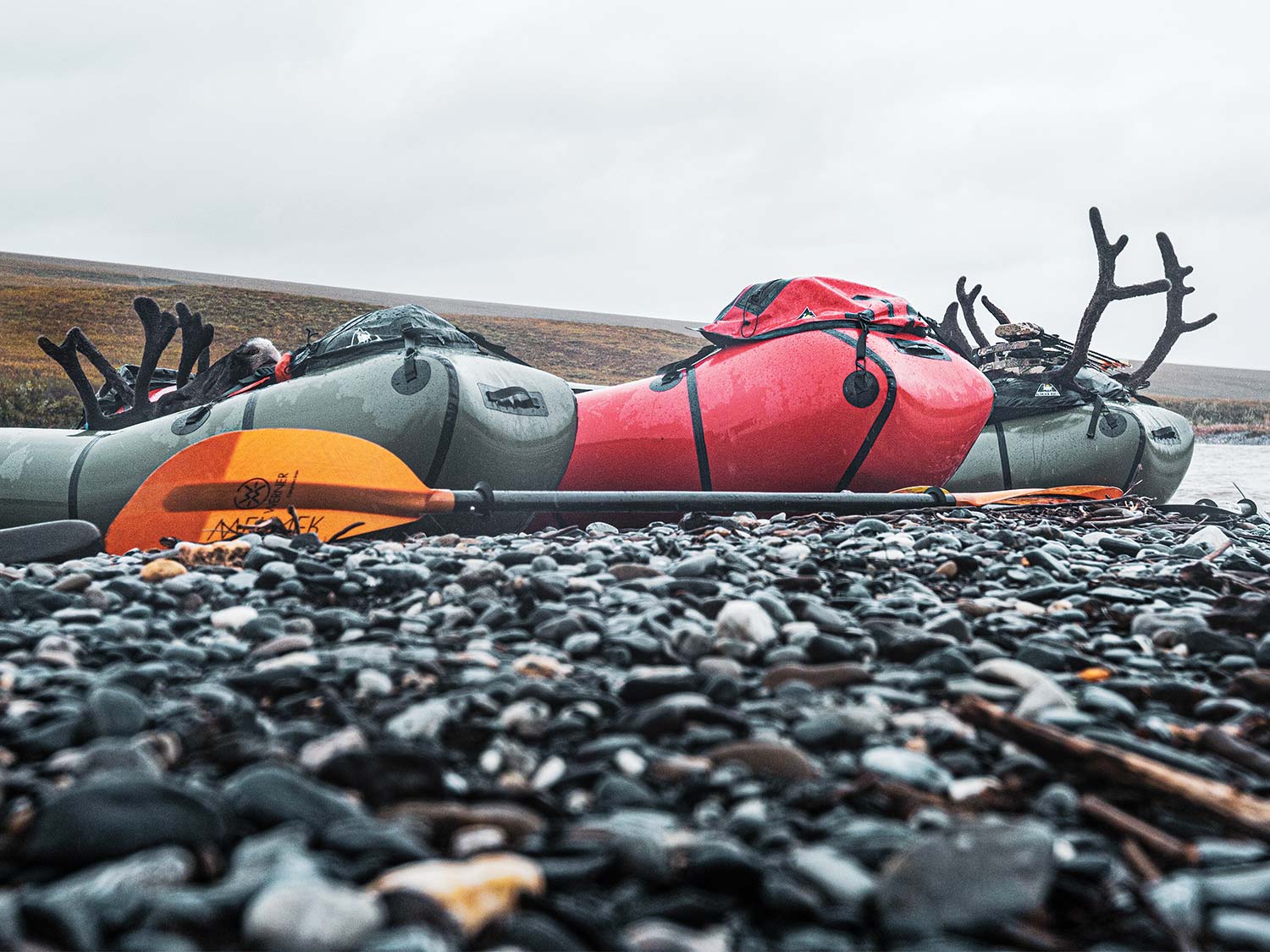
Run It Right
Keep your Alaskan float-hunt dream from turning into a nightmare with the proper gear.
By Tyler Freel
I once heard a bit of advice from an old Sourdough on how to prepare for a backcountry float-hunt here in Alaska. It went something like this: First, put on all your clothes, boots, and rain gear, and dump a little sand down your pants. Second, fill your tub with icewater and leave the showerhead running on cold. Sit down in the water and lift a 45-pound weight up and down in front of you for a few hours. Repeat every day for a week or so, and you’ll get the idea.
A slight exaggeration? Maybe. But I’ve been on a few grueling river hunts myself, and the old man was on to something.
Alaska has some truly incredible opportunities for the aspiring river hunter, but these trips are also fraught with challenges. You need a combination of timing, logistics, and a little help from Mother Nature. Whether you’re paddling a raft or running a jet boat, taking a DIY adventure or working with an outfitter, these lessons I’ve learned over years of hunting Alaskan rivers will help you be more successful—and safer.
Pack the Right Gear and Tools
On any river hunt, you must evaluate every gear item by its utility versus its weight. You’ll get a max weight figure based on the vessel you’re hunting from and how you’re traveling to the put-in. If you’re flying out, your air service will provide you with your maximum gear allowance, which can vary from 50 to 500 pounds.
It’s then up to you to whittle your gear down to the essentials. And be sure to leave enough room and weight allowance for the meat and antlers you’re hoping to bring home.
You’re almost certain to get everything wet at one point or another, so waterproof and corrosion-resistant equipment is a must. Everyone has their personal preferences on gear, and sometimes I’ll bring hefty items, such as a heavy-duty tent with a small wood stove, knowing I’ll have to cut weight in other places. But on any river hunt, always make sure to have chest waders, a rope-along or come-along (a lifesaver for pulling your boat off a sandbar or hoisting a moose out of the water for field dressing), fast-drying synthetic clothing, and heavy-duty rubber rain gear.
Along with your hunting and camping gear, you should have the tools required to handle just about any mechanical failure. If you plan to run a jet boat, this means you also need a basic working knowledge of a jet motor so you can fix it when it breaks down—and trust me, it will break down. The right know-how and tools can keep an inconvenience from becoming a trip-ending disaster. If you’re rafting, you must be ready to find leaks and patch holes. And make sure you have the basic tools to tighten the screws on your riflescope rings.
An ax is usually required, but it might be worth the extra weight and hassle to pack along a chainsaw to cut away sweepers (those overhanging limbs that block the river). The more remote and narrow the river, the more sweepers you’ll meet.
Prioritize Safety and Navigation
If you’re on water deep enough to float, you need a personal flotation device. I never used to wear one, but then one spring, a family friend, who was an experienced outdoorsman, died in a drowning accident. He wasn’t wearing a PFD. Now I always wear mine.
The PFD is just the start. You should have basic survival tools stashed in it, including a good knife, fire starters (a cut-down, sealed road flare is a great signal and fire-starter combo), an emergency space blanket, and your communication device, all sealed in a ziplock bag.
Navigation tools are also essential. On a float-hunt, your direction of travel is obvious—you’re floating downstream. However, wander a few hundred yards away from the river at twilight, and finding your way back can sometimes be much more difficult than you’d think. A compass and a map are a given, but you should also have a GPS with satellite communication ability.
Check Your Equipment (and Your Mindset)
Master these two rules before you ever hit the water: Know your gear and study the river.
Familiarize yourself with any new equipment you’ll be using, even if you’re renting rafts and other gear. Do some research so you know the ins and outs of each item of gear and how to use it. Put the equipment to use before the big trip. If you’re bringing a packraft, get some basic experience using it on moving water while it’s fully loaded. Many rafts are much more difficult to handle when full with meat.
Then do whatever you can to learn about reading river water and the behavior of the waterway you will be on. Research the basics (it’s amazing what you can dig up online), and try to find people who have made the trip before. They probably won’t spill all their secrets, but they might share information on obstacles and hazards to look out for. If you’re working through an outfitter, call each one of their references. This can prevent a lot of unnecessary calamity and frustration.
Preparation is important, but it does no good if you make careless decisions in the moment. We tend to worry about the big stuff, like charging bears or massive storms. But in reality, you have a much greater chance of getting into a dangerous situation by accidentally cutting yourself while cleaning an animal or splitting kindling for the fire. A lapse in focus can cause you to float right into a logjam or a mess of sweepers, potentially ripping you off your raft, tearing a hole in it, or pinning it in an immovable spot. I once watched a guy try to check his outboard while running, and he quartered his boat right into the cut bank of the river. He almost threw his passengers into the deep, fast-flowing water at dusk.
Sure, even with the most carefully crafted game plan, you’re going to be thrown a few curveballs, but that’s half the fun. Keep your cool and your eyes on the water, and you’re sure to have the adventure of a lifetime.
